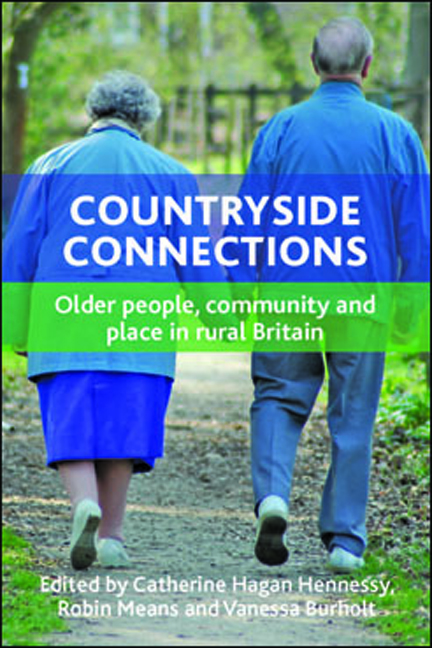Book contents
- Frontmatter
- Contents
- List of tables and figures
- Acknowledgements
- Notes on contributors
- Foreword
- one Countryside connections in later life: setting the scene
- two Conceptualising rural connectivities in later life
- three Rural connectivity and older people’s leisure participation
- four Connecting with community: the nature of belonging among rural elders
- five Beyond transport: understanding the role of mobilities in connecting rural elders in civic society
- six Deep mapping and rural connectivities
- seven Older people, low income and place: making connections in rural Britain
- eight Connecting with older people as project stakeholders: lessons for public participation and engagement in rural research
- nine Towards connectivity in a Grey and Pleasant Land?
- Index
six - Deep mapping and rural connectivities
Published online by Cambridge University Press: 04 March 2022
- Frontmatter
- Contents
- List of tables and figures
- Acknowledgements
- Notes on contributors
- Foreword
- one Countryside connections in later life: setting the scene
- two Conceptualising rural connectivities in later life
- three Rural connectivity and older people’s leisure participation
- four Connecting with community: the nature of belonging among rural elders
- five Beyond transport: understanding the role of mobilities in connecting rural elders in civic society
- six Deep mapping and rural connectivities
- seven Older people, low income and place: making connections in rural Britain
- eight Connecting with older people as project stakeholders: lessons for public participation and engagement in rural research
- nine Towards connectivity in a Grey and Pleasant Land?
- Index
Summary
Introduction
This chapter reflects on a project carried out by a small arts and humanities team that explored older adults’ connectivity in the physical, social and cultural landscapes of North Cornwall as part of the larger Grey and Pleasant Land (GaPL) research programme. The research team comprised members with disciplinary backgrounds in the visual arts, digital media and cultural area studies with methodological expertise in ethnography.
The approach adopted in this work was that of ‘deep mapping’, a process of engaging with place in temporal depth; weaving together multiple voices, impressions and images from conversational exchange and fieldwork. In this case, deep mapping was used to create a multimedia ‘digital landscape’ of fragments derived from interactions with a particular rural locality. This project, Either Side of Delphy Bridge (ESDB), focused on older people's connectivity with and through their rural environments around Delphy Bridge, North Cornwall, and set out to evoke ‘place’ as a lived landscape of multiple connectivities. Place was understood here as a fundamentally dynamic constellation of performative and geographically grounded ‘narratives’ (Casey, 1993; Ingold, 2000, 2011; Massey, 2005) – including those implicit in images – and as the a priori of rural connectivity. The project's underlying methodological concerns included questions of interdisciplinarity and, concurrently, multi-vocality. These provide our focus here.
Based at Place, Location, Context and Environment (PLaCE International) Research Centre (England) in the Faculty of Creative Arts at the University of the West of England (UWE), the research team drew on various practices – including ethnographic and geographic fieldwork, interactive design, and the arts – both in developing ESDB and in reflecting on it. The blended analysis in this chapter reflects both on the connectivities of older adults that were central to ESDB and on the connectivities involved in the research process itself. The relation between the deep mapping process and the places and people whose perceptions, stories and images feed into it is the emphasis of additional critical reflection.
These concerns/perspectives led us to ask: what role can deep mapping play when it is adopted as a method within a wider interdisciplinary study of rural older adults’ connectivity? And, what questions arise from this role with regard to deep mapping's relationship to the social sciences? We seek to clarify these questions here.
- Type
- Chapter
- Information
- Countryside ConnectionsOlder People, Community and Place in Rural Britain, pp. 159 - 192Publisher: Bristol University PressPrint publication year: 2014



